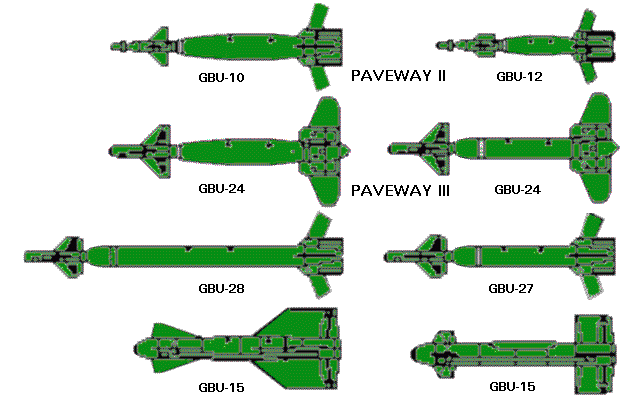



The development of laser quidided weapons has dramatically improved the accuracy of weapon quidance and delivery. With the assistance of build-up guidance kits, general GP bombs are turned into laser-guided bombs (LGBs). The kits consist of a computer- control group (CCG), guidance canards attached to the front of the warhead to provide steering commands, and a wing assembly attached to the aft end to provide lift. LGBs are maneuverable, free-fall weapons requiring no electronic interconnect to the aircraft. They have an internal semiactive guidance system that detects laser energy and guides the weapon to a target illuminated by an external laser source. The designator can be located in the delivery aircraft, another aircraft, or a ground source. All LGB weapons have a CCG, a warhead (bomb body with fuze), and an airfoil group. The computer section transmits directional command signals to the appropriate pair(s) of canards. The guidance canards are attached to each quadrant of the control unit to change the flightpath of the weapon. The canard deflections are always full scale (referred to as "bang, bang" guidance). The LGB flightpath is divided into three phases: ballistic, transition, and terminal guidance. During the ballistic phase, the weapon continues on the unguided trajectory established by the flightpath of the delivery aircraft at the moment of release. In the ballistic phase, the delivery attitude takes on additional importance, since maneuverability of the UGB is related to the weapon velocity during terminal guidance. Therefore, airspeed lost during the ballistic phase equates to a proportional loss of maneuverability. The transition phase begins at acquisition. During the transition phase, the weapon attempts to align its velocity vector with the line-of-sight vector to the target. During terminal guidance, the UGB attempts to keep its velocity vector aligned with the instantaneous line-of- sight. At the instant alignment occurs, the reflected laser energy centers on the detector and commands the canards to a trail position, which causes the weapon to fly ballistically with gravity biasing towards the target."In World War II it could take 9,000 bombs to hit a target the size of an aircraft shelter. In Vietnam, 300. Today we can do it with one laser-guided munition from an F-117."
USAF, Reaching Globally, Reaching Powerfully: The United States Air Force in the Gulf War (Sept. 1991), p. 55.

Laser designators and seekers use a pulse coding system to ensure that a specific seeker and designator combination work in harmony. By setting the same code in both the designator and the seeker, the seeker will track only the target designated by the designator. The pulse coding is based on Pulse Repetition Frequency (PRF). The designator and seeker pulse codes use a truncated decimal system. This system uses the numerical digits 1 through 8 and the codes are directly correlated to a specific PRF. Dependent upon the laser equipment, either a three digit or a four digit code can be set. Coding allows simultaneous or nearly simultaneous attacks on multiple targets by a single aircraft, or flights of aircraft, dropping laser guided weapons (LGWs) set on different codes. This tactic may be employed when several high priority targets need to be expeditiously attacked and can be designated simultaneously by the supported unit(s).
Fire control laser systems are laser rangefinders (LRFs) and laser designators (LDs). These laser systems can be far more harmful to the eye than laser training devices such as MILES and Air-to-Ground Engagement System/Air Defense (AGES/AD) laser simulators. Consequently, fire control lasers require control measures to prevent permanent blindness to an unprotected individual viewing the laser system from within the laser beam.LGB are excellent performers in dive deliveries initiated from medium altitude. A steep, fast dive attack increases LGB maneuvering potential and flight ability. Medium altitude attacks generally reduce target acquisition problems and more readily allow for target designation by either ground or airborne designation platforms. Medium altitude LGB dive delivery tactics are normally used in areas of low to medium threat.
LGBs can miss the target if the laser is turned on too early. During certain delivery profiles where the LGB sees laser energy as soon as it is released, it can turn from its delivery profile too soon and miss by falling short of the target. To prevent this, the laser designator must be turned on at the time that will preclude the bomb from turning down toward the target prematurely. Normally, the pilot knows the proper moment for laser on. The specific LGB and the delivery tactics of the fighter/attack aircraft dictates the minimum designation time required to guide the weapon to the intended target. The effects of smoke, dust, and debris can impair the use of laser-guided munitions. The reflective scattering of laser light by smoke particles may present false targets. Rain, snow, fog, and low clouds can prevent effective use of laser-guided munitions. Heavy precipitation can limit the use of laser designators by affecting line-of-sight. Snow on the ground can produce a negative effect on laser-guided munition accuracy. Fog and low clouds will block the laser-guided munition seeker's field of view which reduces the guidance time. This reduction may affect the probability of hit.The three generations of Paveway LGB technology exist, each successive generation representing a change or modification in the guidance mechanism. Paveway I was a series of laser guided bombs with fixed wings. Paveway II [with retractable wings] and Paveway III are the Air Force designations for 500- and 2,000-pound-class laser-guided bombs (LGBs). A guidance control unit is attached to the front of the bomb, and a wing assembly is attached on the rear. Both generations are compatible with current Army, Navy (Marine), and Air Force designators. Paveway II and III have preflight selectable coding. Paveway III is the third-generation LGB, commonly called the low-level laser-guided bomb (LLLGB). It is designed to be used under relatively low ceilings, from low altitude, and at long standoff ranges.
| Designation | Guideance System | Munition |
|---|---|---|
| GBU-2 | KMU-421/B | SUU-54/b 2000-lb cluster bomb |
| PAVEWAY I | ||
| GBU-10 A/B | KMU-351 A/B | Mk 84 2000-lb bomb |
| GBU-12 A/B | KMU-388 A/B | Mk 82 500-lb SNAKEYE |
| GBU-12 A/B | KMU-420 /B | Mk 20 Mod 2 ROCKEYE 500-lb bomb |
| GBU-12 A/B | KMU-342 /B | M117 750-lb bomb |
| PAVEWAY II | ||
| GBU-10 D/B | KMU-351 E/B | Mk 84 2000-lb bomb |
| GBU-12 C/B | KMU-388 C/B | Mk 82 SNAKEYE 500-lb bomb |
| GBU-16 C/B | KMU-455 /B | Mk 83 1000-lb bomb |

During Desert Storm, the F-111F and the F-117 accounted for the majority of the guided bomb tonnage delivered against strategic targets. The Navy's A-6E capability to deliver LGBs was used only sparingly, despite the fact that the 115 A-6Es deployed constituted almost 51 percent of all US LGB-capable aircraft on the first day of Desert Storm. laser sensor systems demonstrated degradation from adverse weather, such as clouds, rain, fog, and even haze and humidity.
Videotapes of LGBs precisely traveling down ventilator shafts and destroying targets with one strike, like those televised during and after Desert Storm, can easily create impressions about the effect of a single LGB on a single target, which was summed up by an LGB manufacturer's claim for effectiveness: "one target, one bomb." The implicit assumption in this claim is that a target is sufficiently damaged or destroyed to avoid needing to hit it again with a second bomb, thus obviating the need to risk pilots or aircraft in restrikes. However, evidence does not support the claim for LGB effectiveness summarized by "one target, one bomb." In one sample of targets from Desert Storm, no fewer than two LGBs were dropped on each target; six or more were dropped on 20 percent of the targets; eight or more were dropped on 15 percent of the targets. The average dropped was four LGBs per target.
In Desert Storm, 229 US aircraft were capable of delivering laser-guided munitions. By 1996 the expanded installation of low-altitude navigation and targeting infrared for night (LANTIRN) pods on F-15Es and block 40 F-16s had increased this capability within the Air Force to approximately 500 platforms.